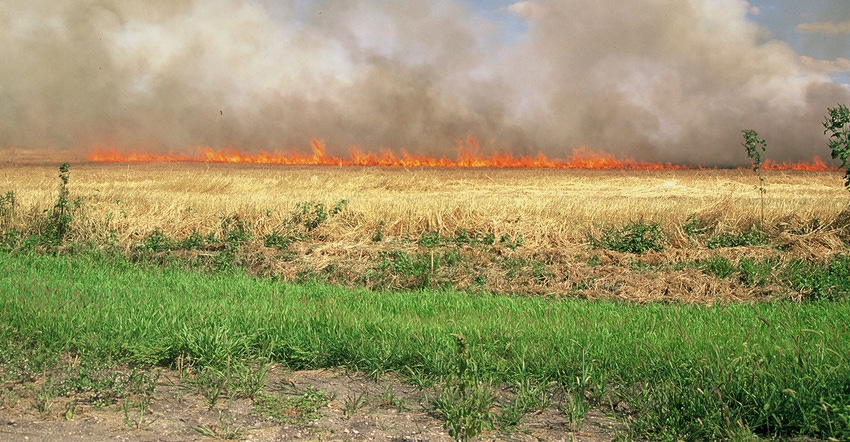July 3, 2017

“Fire safety in the field has two key components — prevention and preparation," says Jay Esperance, of the South Dakota Department of Agriculture Wildland Fire Division (SDWF). "Both are important and can mean the difference between disaster and controlling the situation for minimum of damage or work stoppage."
Prevention tips
To prevent a fire from starting when you are baling or storing hay, SDWF and Tracey Ericksen, South Dakota State University Extension dairy specialist, offer the following tips:
• Remove any trash or plant material accumulation on the baler and take time to blow off dust, leaves and dry stems.
• Make sure all machinery contains an approved fire extinguisher of adequate size that is easily accessible. There are two types of extinguishers, the powder extinguisher for electrical and petroleum-based fires and the water extinguisher for vegetative fires. You may need to carry both kinds.
• Take time to inspect all moving parts for wear or friction before heading out to bale.
• Immediately repair any hydraulic or fuel leaks and clean up any spills. Hydraulic fluid is flammable.
• Store hay away from combustibles, such as gasoline, fertilizers and pesticides, and open burning areas, such as burn barrels and brush piles.
• Leave 30 feet of mowed grass, bare ground or rock between the bale groups, creating a solid fire break.
• When cutting hay in open pastures, make sure the sickle bar or cutting disks are set above any protruding rocks. Sparks from the impact of the metal hitting rocks while cutting hay in pastures or road ditches start wildland fires every year in South Dakota.
• Keep the baler free and clean of oil, grease or hydraulic fluid accumulation, which also attracts and holds dust while baling and is highly ignitable.
• Make the extinguisher easy to access, and check it to make sure it is still adequately charged with fire retardant and is not beyond its expiration date.
• Carry a minimum of 4 gallons of water to use if a fire would ignite.
• Have a shovel or spade with you to throw dirt on a fire or pat out the "hot" spots.
• Do not overfill the fuel tank as the overflow of fuel can have a potential to ignite. These spills should be cleaned up immediately.
• Shut off the engine and electrical equipment while filling the fuel tank. The fuel nozzle should be grounded against the filler neck to avoid sparks.
• If welding repairs are required, take care not to weld near pipes, tubes or hoses filled with flammable fluid such as gas, oil or hydraulic oil.
• Do not smoke near the baler or tractor as this adds to the potential for a spark that will start a fire.
Preparation tips
To be prepared for a fire, SDWF and Ericksen say to:
• Make sure your cellphone battery is charged or your communications radio is working.
• Let someone know where you will be working.
• Call 911 immediately if a fire starts.
• Provide clear, concise directions to your location. Many field and bin sites do not have 911 addresses, so be prepared to identify an intersection or landmark to help responders find the exact location.
• Help control field fires until firefighters arrive by quickly disking a fire break approximately 15 feet wide around the fire.
• With a structural fire, make sure there are no flammable objects nearby.
• Turn off a building's electricity if you can get to the circuit panel safely.
• Evacuate any livestock if time allows.
• Spray water on any surrounding vegetation or structures, discouraging spreading embers.
• Do not take risks.
• Look over equipment used to fight a fire thoroughly for any embers that may start the equipment on fire.
Source: SDDA and SDSU
You May Also Like




